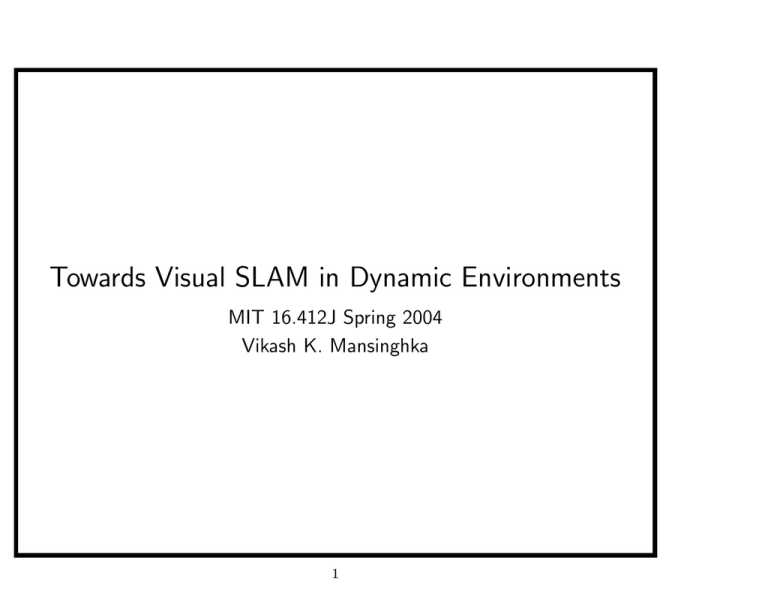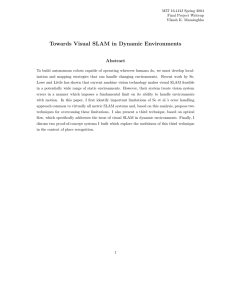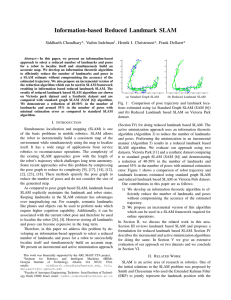Document 13479947
advertisement

Towards Visual SLAM in Dynamic Environments MIT 16.412J Spring 2004 Vikash K. Mansinghka 1 Key Points • Visual metric SLAM in environments with motion is an open problem • SIFT SLAM error handling makes odd choices: – Cheats on position estimation (by trusting vision) - see report – Sets arbitrary matching thresholds for vision • These choices impact SLAM performance: – Imposes a limit on motion error (odometry vs. actual) – Slow-moving objects can arbitrarily foul localization – Matching thresholds may not be best (though “good enough”) • Partial solution: Minimize uncertainty and use optical flow 2 SIFT Landmark Tracking • Predict where landmarks should appear (reliability, speed) • Note: Robot moves in xz plane • Given [p, q, δ] and old relative position [X, Y, Z], find expected position [X , Y , Z ] by: X = (X − p)cos(δ) − (Z − q)sin(δ) Y = Y Z = (X − p)sin(δ) − (Z − q)cos(δ) • By pinhole camera model ((u0 , v0 ) image center coords, I interocular distance, f focal length): Y � r = v0 − f Z � � c = u0 + f X Z � d = f ZI � σ = σ ZZ� 3 SIFT Landmark Tracking • V is camera field of view angle (60 degrees) • A landmark is expected to be in view if: Z > 0 � −1 |X | tan ( Z � ) < � −1 |Y | tan ( Z � ) < V 2 V 2 • An expected landmark matches an observed landmark if: – Obs. center within a 10x10 region around expected – Obs. scale within 20% of expected – Obs. orientation within 20 degrees of expected – Obs. disparity within 20% of expected 4 Impact of Loose Matching Tolerance • Mario does not know landmarks on Wario come from same source • Robot (Mario) confused as long as Wario moves slowly 5 Possible Solution • Add landmarks only when sensor error very low (robot stationary) • Do not accept landmarks from image regions with motion • Approximate motion either via SIFT matching or other optical flow scheme • Alternately: Only trust largest set of consistent errors (how?) 6 Horn-Schunck Optical Flow • Let E(x, y, t) be image brightness at pixel (x, y) at time t • Goal: find u = • Assume ∂E dx ∂x dt dx dt + and v = ∂E dy ∂y dt + dy dt ∂E ∂t (horiz, vert flow) =0 • Also minimize measures of the departure from smoothness and above assumption • One set of choices yields coupled PDEs: �2 u = λ(Ex u + Ey v + Et )Ex and �2 v = λ(Ex u + Ey v + Et )Ey 7 Proof of Concept for Optical Flow • Uses Horn-Schunck optical flow; could use SIFT matching • First demo prunes landmarks which move/are missed too much • Second demo attempts place recognition by ignoring features on moving image regions 8 Simple Results (Courtesy of Neil Alexander. Used with permission.) • A restrictive optical flow threshold (0.1) reliably prunes features on moving objects 9 Place Recognition Results • Matching threshold of 20% • Lowering the optical flow threshold from 30 to 1 raised performance from 43% to 56% in an image with motion • Low performance due primarily to naive place recognition approach 10 Contributions • Identified limitation in SIFT error handling; probably present in other SLAM systems • Suggested simple optical flow technique for enabling dynamic visual SLAM • Suggested other techniques for improving visual SLAM performance (see report) 11






